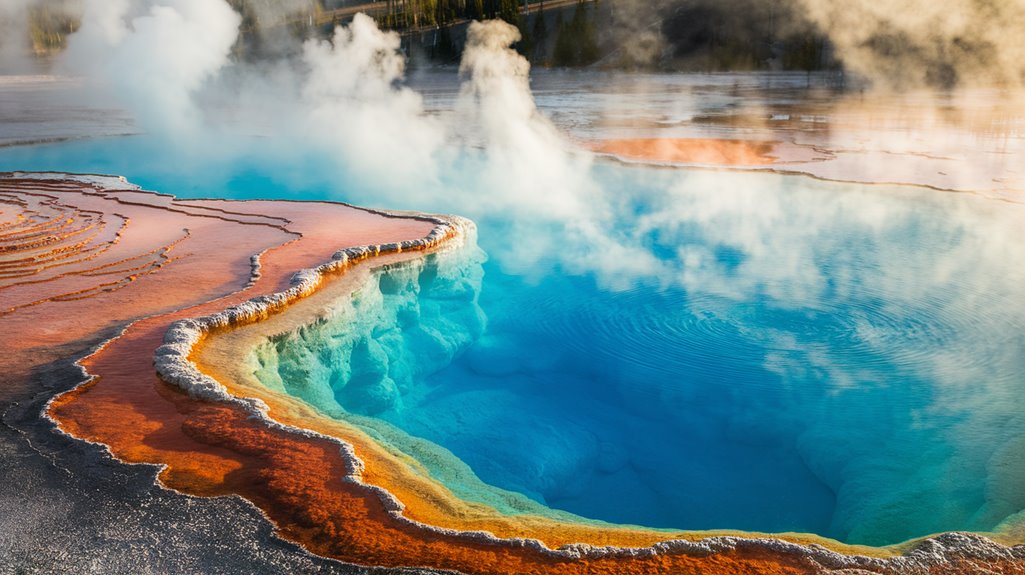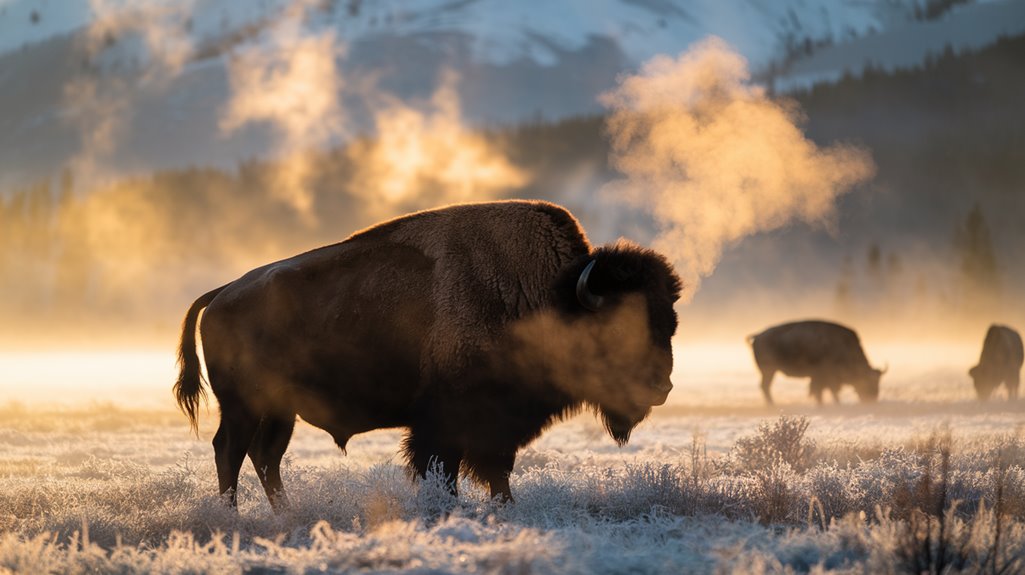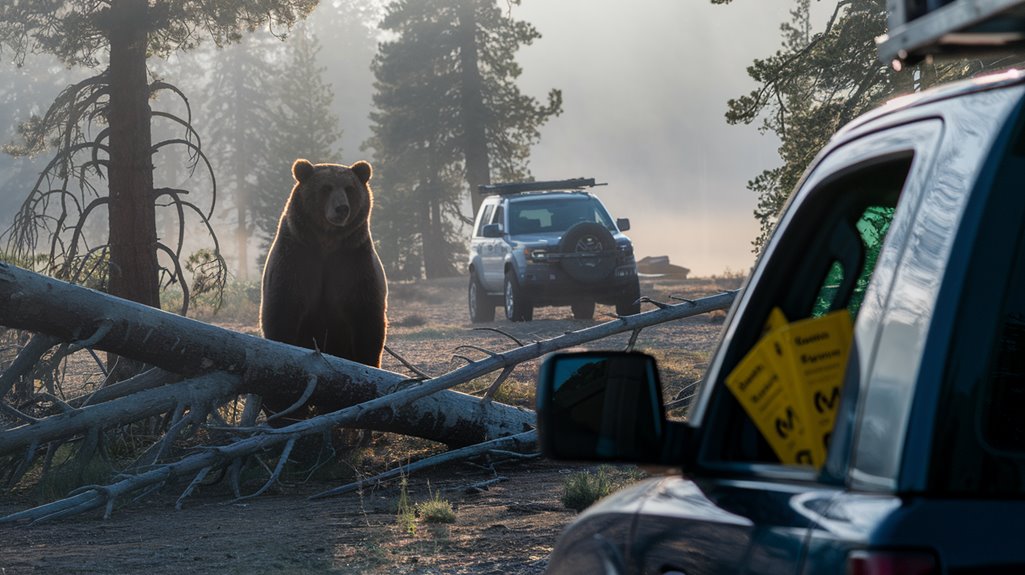Did you know that beneath your feet at Yellowstone lies a volcanic hotspot capable of producing an eruption 1,000 times more powerful than Mount St. Helens? This sleeping giant is responsible for creating the world's largest concentration of geothermal features, including the famous Old Faithful geyser. As you plan your visit to Yellowstone's geyser basins, you'll need to understand the distinct characteristics of each area, ideal viewing times, and essential safety measures. The park's dynamic landscape presents more than just spectacular shows of steam and water—it provides a rare glimpse into Earth's raw geological power, and you're about to uncover how to enjoy it safely.
Key Takeaways
- Upper Geyser Basin contains Old Faithful and offers the highest concentration of geysers, making it essential for first-time visitors.
- Visit geysers during early morning hours to avoid crowds and secure better parking, especially at popular basins.
- Stay on marked boardwalks and maintain 25-foot distance from thermal features to ensure safety throughout geyser basins.
- Norris Geyser Basin features the park's hottest thermal activities, including the world's tallest active geyser, Steamboat Geyser.
- September and October provide optimal visiting conditions with mild temperatures and fewer tourists for exploring geyser basins.
Origins and Geologic Formations
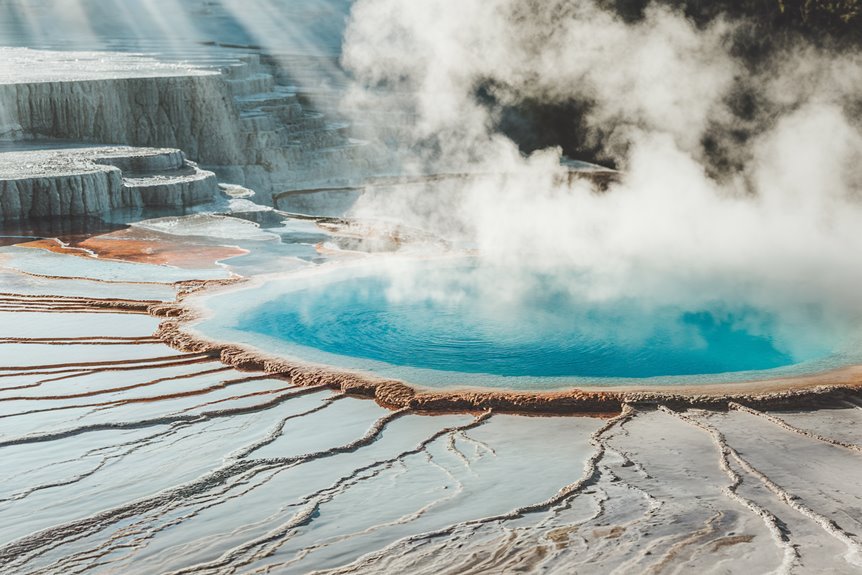
The sheer power of volcanic forces shaped Yellowstone's dramatic landscape over millions of years. You'll find evidence of three massive eruptions that occurred 2.1 million, 1.2 million, and 640,000 years ago, creating the park's massive caldera measuring 34 by 45 miles.
Below the surface, a huge magma chamber continues to fuel the park's geothermal activity. As the North American plate moves southwest at 1.8 inches per year, it interacts with this hotspot, which acts like a blowtorch beneath the Earth's crust.
You'll notice two prominent features called resurgent domes – Sour Creek and Mallard Lake – that rise and fall as magma pressure shifts beneath them. This volcanic activity has created an intricate underground plumbing system that powers the park's famous geysers and hot springs.
Major Thermal Features
Yellowstone's underground plumbing system creates five distinct types of thermal features you'll encounter throughout the park's geyser basins.
Geysers are the most dramatic, erupting periodically when superheated water bursts through narrow channels, reaching heights up to 390 feet. You'll find hot springs with larger channels that allow continuous water circulation, preventing the explosive displays of their geyser cousins.
Look for fumaroles or steam vents where there's insufficient water to form pools, and you'll spot mudpots where superheated steam creates bubbling mud explosions.
The park's travertine terraces offer a unique sight, formed when thermal water rises through limestone, depositing white calcium carbonate in striking terraced formations. Each feature maintains temperatures around 199°F due to Yellowstone's high elevation.
Where to Find Geysers
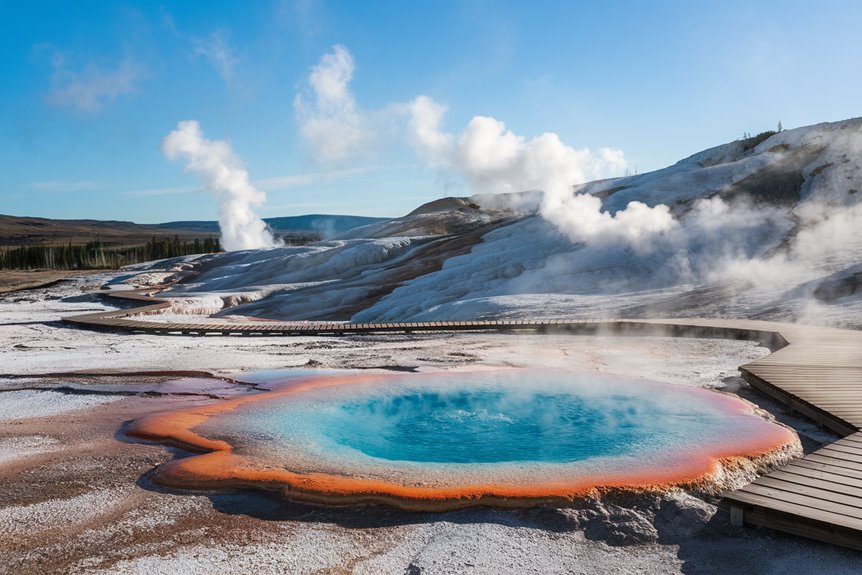
Distinct geyser basins dot Yellowstone's landscape, each providing unique thermal features and viewing encounters.
You'll find the hottest thermal features at Norris Geyser Basin, including Steamboat Geyser, the world's tallest active geyser. For easy access, head to Lower Geyser Basin via Firehole Lake Drive, where you can explore Fountain Paint Pots and witness bubbling mud formations.
The Upper Geyser Basin presents the park's most concentrated collection of geysers, including Old Faithful and the stunning Grand Prismatic Spring.
If you're seeking solitude and exploration, trek to the remote Shoshone and Heart Lake Geyser Basins, which require a 15-20 mile round trip hike. These less-visited areas showcase nearly 200 combined thermal features, though you'll want to bring an experienced guide due to the lack of boardwalks.
Best Times to Visit
Knowing when to plan your Yellowstone geyser excursion can make all the difference in your journey. For fewer crowds and comfortable conditions, visit during September and October when autumn colors emerge and temperatures remain mild for hiking.
If you're set on summer travel, prepare for July's warmth and heavy tourism at the geysers.
Time your daily visits strategically. You'll find shorter lines and better parking at Old Faithful and Upper Geyser Basin during morning hours.
The afternoon brings larger crowds and parking challenges throughout the park, though it's an excellent time for wildlife viewing in Hayden Valley.
During winter months, access becomes limited, with most roads closed except for the northernmost entrance.
Spring provides a gradual return to accessibility, with the west entrance opening mid-April and remaining entrances following in May.
Understanding Eruption Patterns
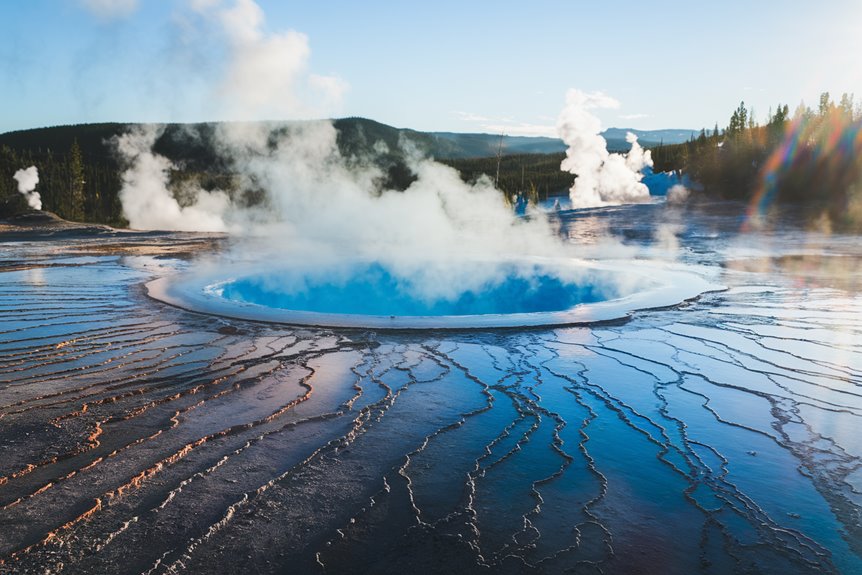
The complex patterns of geyser eruptions tell a fascinating story of underground forces at work. You'll find that these patterns aren't random but influenced by various factors, including seismic activity, seasonal changes, and groundwater levels.
When you're observing Old Faithful, you'll notice it typically erupts every 92 minutes, though sometimes it shifts to a shorter 60-65 minute interval. This bimodal pattern reflects the dynamic nature of Yellowstone's hydrothermal system.
You'll see that longer eruptions generally lead to longer recharge times, while shorter eruptions result in quicker intervals.
As you explore the geyser basins, you'll witness how earthquakes can alter eruption patterns by changing underground water flow. New thermal features can emerge suddenly, as demonstrated by recent activity on Geyser Hill, constantly reshaping the landscape you're experiencing.
Safety and Trail Guidelines
While understanding geyser patterns enriches your visit, staying safe around these powerful thermal features is a matter of life and death. You must stay on marked trails and boardwalks at all times, as the ground surrounding thermal features can be dangerously thin and conceal scalding water beneath.
Keep at least 25 feet away from all thermal features and never throw objects into them.
- More than 20 visitors have lost their lives by entering or falling into hot springs
- Ground temperatures can exceed boiling point and cause severe, fatal burns
- Thin crusts can collapse without warning, plunging you into scalding water
- One wrong step off the boardwalk could be your last
Always heed warning signs, supervise children closely, and report any safety concerns to park rangers immediately.
Your safety depends on following these vital guidelines.
Frequently Asked Questions
Can You Swim or Bathe in Any of Yellowstone's Thermal Features?
No, you can't swim or bathe in Yellowstone's thermal features – it's strictly prohibited and extremely dangerous. You could suffer fatal burns, as temperatures exceed 200°F. Only use designated swim areas like Firehole instead.
What Causes the Different Vibrant Colors in the Hot Springs?
Like nature's paintbrush, you'll find that different thermophilic bacteria create the hot springs' vibrant colors. They thrive at specific temperatures, with each species producing unique hues through their protective pigments and photosynthetic processes.
How Do Rangers Predict Old Faithful's Eruption Times so Accurately?
You'll find rangers predict Old Faithful using duration-based timing and statistical models. They'll track each eruption with stopwatches, analyze the data, and achieve 90% accuracy within a 20-minute prediction window.
Why Do Some Geysers Stop Erupting While New Ones Suddenly Appear?
You'll find geysers change when underground plumbing shifts due to earthquakes or pressure changes. This can block existing water channels and create new ones, causing some geysers to die while others spring to life.
Do Winter Temperatures Affect Geyser Eruption Patterns and Frequency?
While winter temps can drop to -18°C, there's no direct evidence that cold affects geyser eruption patterns. You'll notice visual changes though, as the steam creates stunning ice formations and frozen mist displays.
